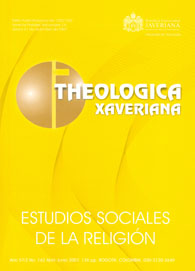Abstract
Body is a cultural experience. The social, political and religious transformations of the XVI and XVII centuries altered the relation of the body to mysticism. A narrative field in which this change was felt were the baroque biographies, in which corporeity enriched the spirituality: trances, maladies and mortifications appeared on the scene in a way different from that treated in medieval hagiographies. The narratives found in the exemplary lives of the colonial period of New Granada about people who died with a reputation of sanctity assumed this new experience of the body. In these texts, addressed to lay readers, one can observe the place held by mortification and penance in relation with this new experience in the colonial period.
This journal is registered under a Creative Commons Attribution 4.0 International Public License. Thus, this work may be reproduced, distributed, and publicly shared in digital format, as long as the names of the authors and Pontificia Universidad Javeriana are acknowledged. Others are allowed to quote, adapt, transform, auto-archive, republish, and create based on this material, for any purpose (even commercial ones), provided the authorship is duly acknowledged, a link to the original work is provided, and it is specified if changes have been made. Pontificia Universidad Javeriana does not hold the rights of published works and the authors are solely responsible for the contents of their works; they keep the moral, intellectual, privacy, and publicity rights.
Approving the intervention of the work (review, copy-editing, translation, layout) and the following outreach, are granted through an use license and not through an assignment of rights. This means the journal and Pontificia Universidad Javeriana cannot be held responsible for any ethical malpractice by the authors. As a consequence of the protection granted by the use license, the journal is not required to publish recantations or modify information already published, unless the errata stems from the editorial management process. Publishing contents in this journal does not generate royalties for contributors.


